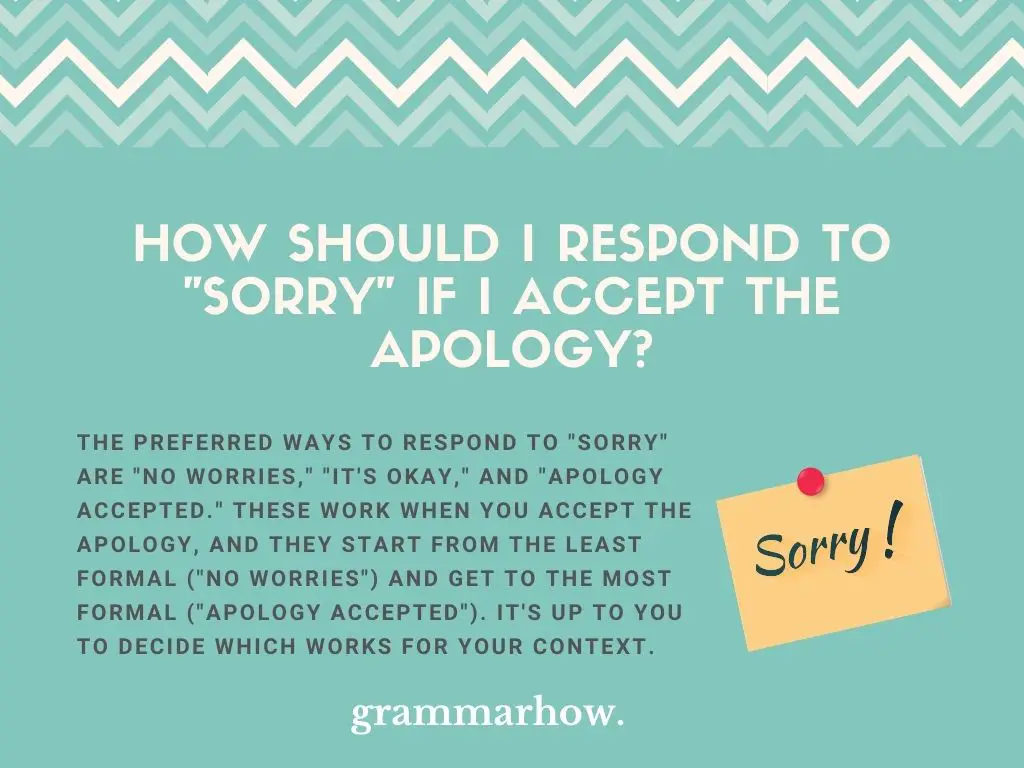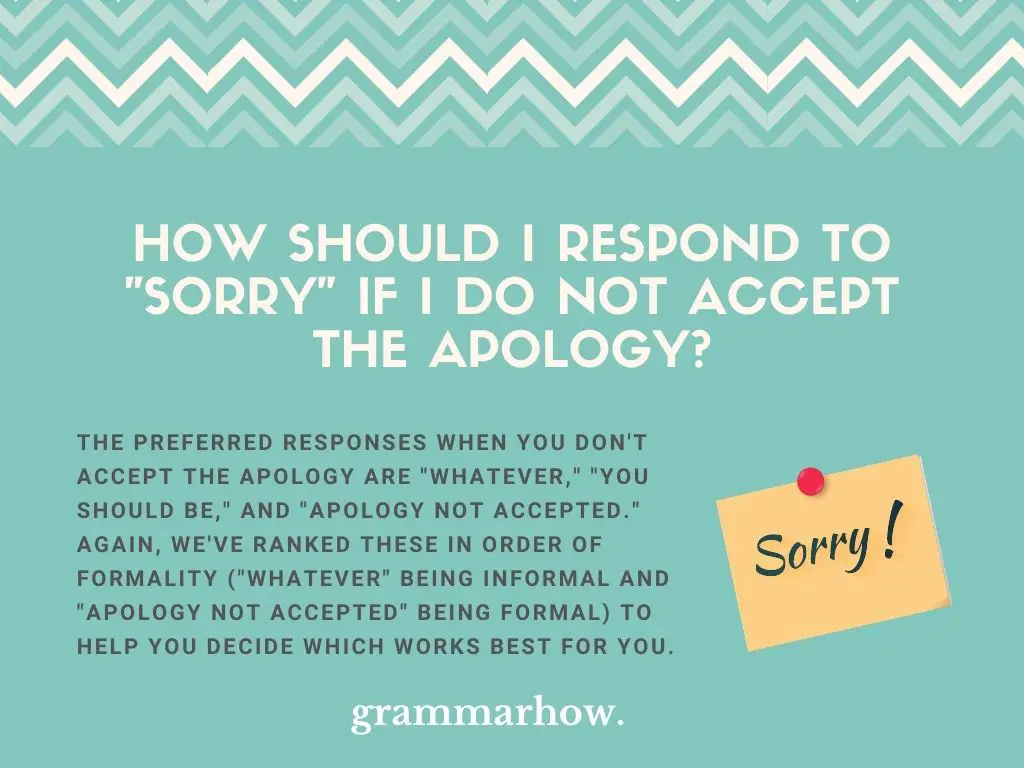“Sorry” is one of the most common things to say in English. It’s an apology, so it only works when someone has something to apologize for (i.e. they regret doing it or feel bad about something). This article will explore the best responses to all the different types of “sorry.”
How Should I Respond To “Sorry” If I Accept The Apology?
The preferred ways to respond to “sorry” are “no worries,” “it’s okay,” and “apology accepted.” These work when you accept the apology, and they start from the least formal (“no worries”) and get to the most formal (“apology accepted”). It’s up to you to decide which works for your context.

No Worries
“No worries” is great informally. You can use this when your friends or family are trying to apologize to you.
It shows that you’re calm and collected, even if someone is convinced they might have hurt or offended you in some manner.
- Sorry! Sorry! Sorry!
- No worries! I wasn’t even paying attention myself.
- I’m really sorry.
- No worries! I’m glad you understand you were wrong, though.
It’s Okay
“It’s okay” is slightly more formal than “no worries.” We use it to show that no harm was done by someone’s actions, and we are willing to accept their apology for the situation.
- I’m sorry, man! I really am!
- It’s okay! I can forgive you for something like that.
- Sorry!
- It’s okay! Just don’t do it again, maybe!
Apology Accepted
“Apology accepted” is great for formal situations. You should use this one when you want to accept an apology from someone in the workplace (or in other formal settings).
It shows that you’re able to forgive and forget in more professional environments, which is a great trait to possess.
- I’m so sorry. Do you forgive me?
- Of course! Apology accepted. I’m happy to move on from this.
- I’m sorry!
- Apology accepted. I didn’t even notice the problem anyway.
Don’t Worry About It
“Don’t worry about it” is another good informal saying. We can use this one to show that someone is thinking too much about whatever they did wrong.
Usually, this works to encourage them to think about something else and stop “worrying” about the issue.
- Sorry, man! I didn’t see you there.
- Don’t worry about it! I probably would have done the same!
- I’m really sorry.
- Don’t worry about it! We all make mistakes sometimes!
You Don’t Have To Apologize
“You don’t have to apologize” shows someone that there is no need for them to say “sorry.” It removes the pressure from the situation, showing that you are able to take the apology with no issues.
- I’m really sorry. Can I do anything to help?
- You don’t have to apologize, for starters. You did nothing wrong.
- Sorry!
- You don’t have to apologize. These things happen, after all.
I’m Fine, Honestly
“I’m fine, honestly” is a great way to accept an apology when someone thinks they might have hurt or offended you. You can use “I’m fine” to show that you’re still okay, even after whatever they said or did.
- I’m sorry! Do you forgive me?
- I’m fine, honestly. I didn’t even notice the problem.
- I’m sorry! Oh my god, I’m sorry!
- I’m fine, honestly. No harm, no foul!
You Don’t Have To Say That
“You don’t have to say that” takes away the need to say “sorry” entirely. It’s another good choice that shows that the person did nothing wrong.
Use this one when you’re not affected by the problem someone might have caused. It shows that they’re overthinking the situation and that you accept their apology with no problems.
- I’m sorry. There must be something I can do.
- You don’t have to say that. I’m fine, honestly.
- I’m so sorry.
- You don’t have to say that, though I appreciate the sentiment.
I Forgive You
“I forgive you” is a simple one. It shows that you accept the apology by “forgiving” the actions or choices of the person that said sorry.
- I’m sorry.
- I forgive you. I can see that you’re hurting too.
- I’m really sorry.
- That’s okay; I forgive you. Thank you for saying that.
Just Don’t Do It Again, Okay?
“Just don’t do it again, okay” is a great way to accept an apology. It shows the person they’re forgiven while also encouraging them not to do whatever it was in the future.
The implication is that if they do it again, you might not be as kind the second time around.
- I’m so sorry!
- Just don’t do it again, okay? What’s done is done.
- I’m sorry! Please forgive me.
- Just don’t do it again, okay? I won’t mention it to anyone.
How Should I Respond To “Sorry” If I Do Not Accept The Apology?
The preferred responses when you don’t accept the apology are “whatever,” “you should be,” and “apology not accepted.” Again, we’ve ranked these in order of formality (“whatever” being informal and “apology not accepted” being formal) to help you decide which works best for you.

Whatever
“Whatever” is an informal way to reject an apology. It shows that you do not care what somebody has to say.
Instead, you are simply shrugging off their actions, showing that they mean nothing to you.
- I’m sorry!
- Whatever. Get out, please.
- I’m really sorry, man.
- Whatever. I don’t think I’ll be able to forgive you for this.
You Should Be
“You should be” confirms that someone needs to apologize. It also shows that you are not pleased with what they did.
It’s a great way to refuse an apology without being direct about your intention.
- I’m really sorry.
- You should be. Do you have any idea what you’ve done to them?
- I’m so sorry.
- As you should be. I’m disappointed that you thought that was a good idea.
Apology Not Accepted
“Apology not accepted” is a great choice for formal situations. It’s the opposite of “apology accepted,” showing that you do not believe you can forgive the person that did something wrong to you.
- I’m sorry about that. Is there anything I can do?
- Your apology is not accepted. You need to give me some time to think.
- I’m so sorry!
- Apology not accepted. Now, please give me a moment alone with my thoughts.
I Don’t Care
“I don’t care” is another good way to dismiss an apology. It works well because it shows that you “don’t care” about the apology (which can also make it seem like you don’t care about the person’s feelings, so be careful to who you say it).
- I’m really sorry. Do you forgive me?
- I don’t care if you’re sorry. I don’t think I could ever forgive you for the things you did.
- I’m sorry! Please accept that.
- I don’t care. Get out of my house. I never want to see you again.
Okay
“Okay” is a blunt answer. If you’re using this one to refuse “sorry,” you should make sure that it’s the only thing you say as part of a sentence.
If you’re going to say more, make sure you emphasize that “okay” is your main response with a period after it.
- I’m sorry. I feel really bad.
- Okay. Well, I’m not accepting it. It’s best if you just leave.
- I’m really sorry. I don’t know what came over me.
- Okay. I think it’s best you go now, though. I don’t want to see you again.
Fine
“Fine” is another great response to show how blunt you are. Being blunt is a tried and tested way to reject someone’s use of “sorry.” Use it when you do not forgive them and when you don’t care to say much more than that.
- Sorry about that.
- Fine. Whatever. Bye.
- I’m so sorry.
- Fine. Is that all you have to say? I think we’re done here.
That Wasn’t Okay
“That wasn’t okay” usually refers to a specific action someone did. If they’re apologizing for a thing they did, you might be able to use this to show that you’re not okay with their action or choices.
- Oh, I’m sorry!
- That wasn’t okay what you did. I hope you feel bad about it.
- I’m so sorry! Do you forgive me?
- No. That wasn’t okay. You need to apologize to all of the people you hurt.
Do You Think That’s Enough?
“Do you think that’s enough” is a great question. It turns the apology around, asking the person whether they think a simple “sorry” is going to make up for whatever problem or mistake they made.
- I’m sorry I did that to you!
- Do you think that’s enough? No. You’ll need to try harder than that.
- I’m so sorry about all of this.
- Do you think that’s enough for me? I don’t care what you have to say.
You’ll Pay For This
“You’ll pay for this” is a spiteful and malicious comment. You should only say this when you have the means to make someone pay for doing what they did wrong.
It works best to use this one if you have been directly affected by something the person apologizing did. Otherwise, it can seem spiteful and vengeful for no good reason.
- I’m really sorry.
- You’ll pay for this. I know where you live, and I’ll make sure you pay.
- I’m so sorry.
- I’ll make sure you pay for this! How could you do something like this to me?

Martin holds a Master’s degree in Finance and International Business. He has six years of experience in professional communication with clients, executives, and colleagues. Furthermore, he has teaching experience from Aarhus University. Martin has been featured as an expert in communication and teaching on Forbes and Shopify. Read more about Martin here.
